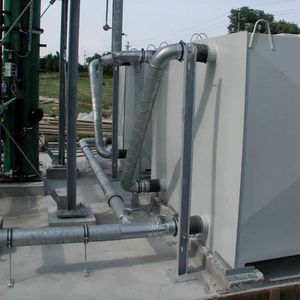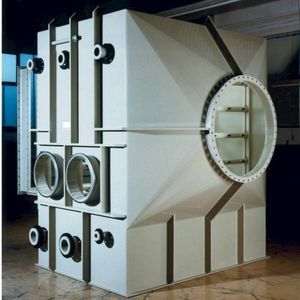
- Hydraulics - Pneumatics
- Filter and Separator
- Activated carbon filtration unit
- Prantner GmbH Verfahrenstechnik
Activated carbon filtration system GVDwaterairautomatic



Add to favorites
Compare this product
Characteristics
- Technology
- activated carbon
- Designed for
- water, air
- Other characteristics
- automatic
Description
Automatic regenerating filters are used especially for concentrations of 0,5 - 20 g/Nm³ with highly chlorinated hydrocarbons such as perchlorethene.
Steam regenerating filter units consist of fully automatic 2 or 3 bed activated carbon filters with an integrated control system. The filters are made from stainless steels or special materials such as PVDF or certain types of glass. Other components include the air blower, a heat exchanger and phase separator.
The contaminated air is initially fed into the first bed. The carbon adsorbs the pollutants from the process air. After the bed is saturated, the process air feed is switched to the second bed.
The first bed then goes through the desorption phase. Steam is blown into the bed, which desorbs the pollutants from the carbon. This steam-pollutant mixture is then fed into a condenser and from there into a separator. In the separator, the flow is then separated into solvent and contact-water.
The solvent flows into a tank, and can then be disposed of.
The contact water is then treated. Prantner boundary layer evaporators (GVD) and strip units are primarily used. The pollutant is stripped out of the water and returned to the inlet of the unit where it is once again picked up by the activated carbon.
Catalogs
No catalogs are available for this product.
See all of Prantner GmbH Verfahrenstechnik ‘s catalogsOther Prantner GmbH Verfahrenstechnik products
EXHAUST AIR TREATMENT
Related Searches
- Centrifugal classifier
- Liquids separator
- Filtration system
- Filter element
- Liquid filtration system
- Oil separator
- Gas filter element
- Absorption filtration system
- Water separator
- Gas filtration system
- Air filter element
- Air filtration system
- Automatic filtration system
- Drum separator
- Iron separator
- Activated carbon filtration system
- Activated carbon filter element
*Prices are pre-tax. They exclude delivery charges and customs duties and do not include additional charges for installation or activation options. Prices are indicative only and may vary by country, with changes to the cost of raw materials and exchange rates.









